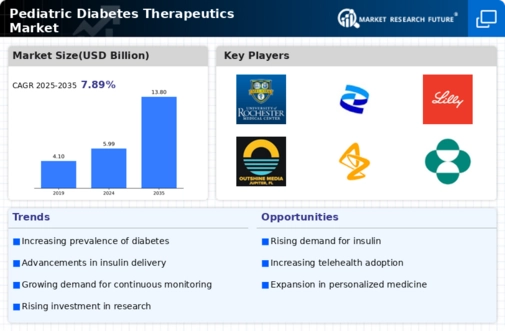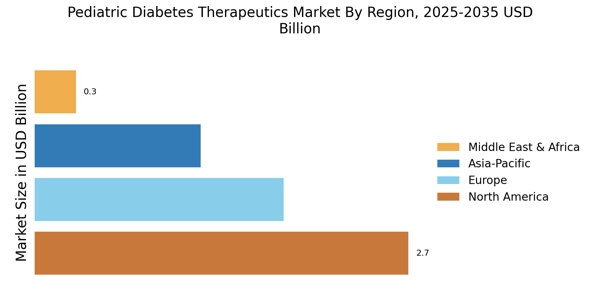Rising Investment in Pediatric Healthcare
The increasing investment in pediatric healthcare is a notable driver for the Pediatric Diabetes Therapeutics Market. Governments and private sectors are recognizing the importance of addressing chronic conditions in children, leading to enhanced funding for research, treatment facilities, and healthcare programs. This financial commitment is crucial for developing innovative therapies and improving access to existing treatments for pediatric diabetes. As healthcare systems evolve to prioritize pediatric care, the demand for specialized diabetes therapeutics is likely to rise. Furthermore, collaborations between pharmaceutical companies and healthcare providers are expected to flourish, fostering an environment conducive to the growth of the Pediatric Diabetes Therapeutics Market.
Growing Awareness and Education Initiatives
Increased awareness and education regarding pediatric diabetes are pivotal in driving the Pediatric Diabetes Therapeutics Market. Healthcare organizations and advocacy groups are actively promoting educational programs aimed at parents, caregivers, and healthcare professionals. These initiatives emphasize the importance of early diagnosis and effective management strategies for children with diabetes. As awareness grows, families are more likely to seek medical advice and treatment options, leading to a higher demand for therapeutic solutions. This trend is further supported by the rise of online resources and community support networks, which provide valuable information and foster a sense of community among affected families. Consequently, the Pediatric Diabetes Therapeutics Market is likely to experience growth as more individuals become informed about available treatment options.
Increasing Prevalence of Pediatric Diabetes
The rising incidence of pediatric diabetes is a primary driver for the Pediatric Diabetes Therapeutics Market. Recent statistics indicate that the prevalence of Type 1 diabetes among children has been increasing steadily, with estimates suggesting that approximately 1 in 300 children are affected. This alarming trend necessitates the development and availability of effective therapeutic options tailored for younger populations. As healthcare providers and families seek to manage this chronic condition, the demand for innovative treatments, including insulin therapies and adjunctive medications, is likely to grow. Consequently, pharmaceutical companies are investing in research and development to address this urgent need, thereby propelling the Pediatric Diabetes Therapeutics Market forward.
Advancements in Technology and Treatment Options
Technological advancements play a crucial role in shaping the Pediatric Diabetes Therapeutics Market. Innovations in diabetes management tools, such as continuous glucose monitors and insulin pumps, have transformed the way pediatric diabetes is managed. These devices not only enhance the quality of life for children but also improve glycemic control, which is essential for long-term health outcomes. Furthermore, the integration of mobile health applications allows for real-time monitoring and data sharing between patients and healthcare providers. As these technologies become more accessible and affordable, they are expected to drive the demand for comprehensive therapeutic solutions in the Pediatric Diabetes Therapeutics Market, fostering a more proactive approach to diabetes management.
Regulatory Support and Incentives for Pediatric Research
Regulatory bodies are increasingly recognizing the need for pediatric-specific research in diabetes therapeutics, which serves as a significant driver for the Pediatric Diabetes Therapeutics Market. Initiatives such as the Pediatric Research Equity Act encourage pharmaceutical companies to conduct studies focused on pediatric populations. This regulatory support not only facilitates the development of age-appropriate therapies but also incentivizes investment in research and development. As a result, more companies are likely to prioritize pediatric diabetes research, leading to a broader range of therapeutic options becoming available in the market. This trend is expected to enhance the overall landscape of the Pediatric Diabetes Therapeutics Market, ultimately benefiting children living with diabetes.


















Leave a Comment